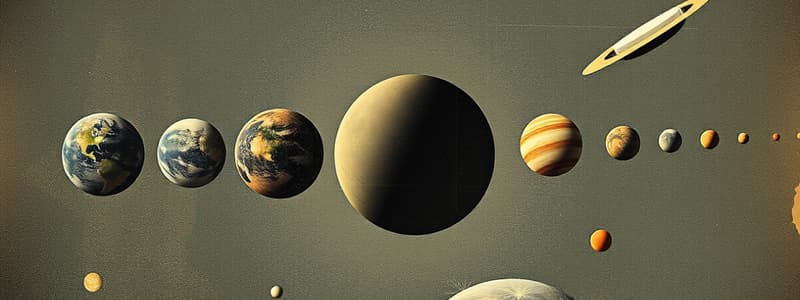Podcast
Questions and Answers
Which of the following constitutes a terrestrial planet?
Which of the following constitutes a terrestrial planet?
- Neptune
- Venus (correct)
- Jupiter
- Saturn
What percentage of Earth's atmosphere is composed of nitrogen?
What percentage of Earth's atmosphere is composed of nitrogen?
- 50%
- 21%
- 1%
- 78% (correct)
Which factor is NOT a condition that supports life on Earth?
Which factor is NOT a condition that supports life on Earth?
- Earth has an atmosphere rich in nitrogen and oxygen.
- Earth's surface is entirely covered in water. (correct)
- Earth has a magnetic field.
- Earth occupies a circumstellar habitable zone.
Which of the following is NOT classified as a type of space object orbiting the sun?
Which of the following is NOT classified as a type of space object orbiting the sun?
What is the primary role of the circumstellar habitable zone?
What is the primary role of the circumstellar habitable zone?
Flashcards are hidden until you start studying
Study Notes
Earth Systems
- Four main Earth systems: Biosphere, Atmosphere, Hydrosphere, Geosphere.
Classification of Space Objects
- Terrestrial Planets: Mercury, Venus, Earth, Mars; solid, rocky surfaces.
- Jovian Planets: Gas giants Jupiter, Saturn, Uranus, Neptune; larger and composed mostly of gas.
- Dwarf Planets: Notable example is Pluto, reclassified due to not meeting planetary criteria.
- Asteroids: Thousands located in the Kuiper Belt, remnants from the solar system's formation.
- Icy Particles: Comets and other icy bodies reside beyond the Kuiper Belt in a spherical shell.
Conditions Supporting Life on Earth
-
Atmospheric Composition:
- 78% Nitrogen: Inert gas, crucial for life forms.
- 21% Oxygen: Essential for respiration and combustion.
- 1% Inert Gases: Includes various elements with minimal reactivity.
- Trace Gases: Presence of Carbon Dioxide, Helium, Argon, although in minuscule amounts.
-
Circumstellar Habitable Zone:
- Earth’s orbit allows for the presence of liquid water, essential for life.
-
Magnetic Field: Protects the planet from solar wind and cosmic radiation, maintaining stability.
-
Stable Climate and Temperature: Earth maintains a relatively stable environment conducive to diverse life forms.
Habitable Zone
- Defined as the region around the sun where conditions are right for liquid water to exist, significantly influencing the potential for life on celestial bodies.
Studying That Suits You
Use AI to generate personalized quizzes and flashcards to suit your learning preferences.




